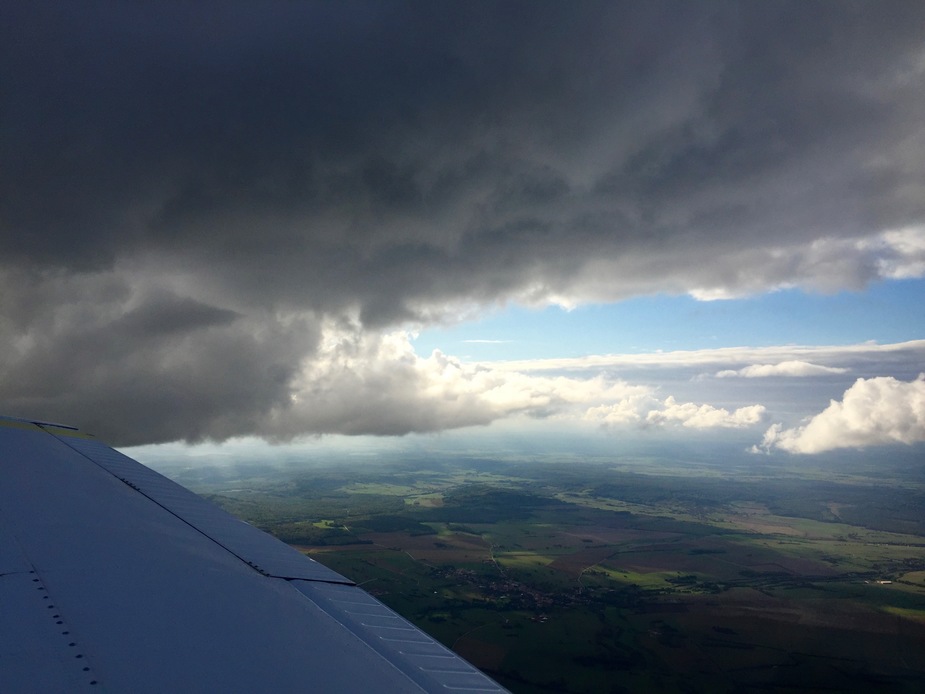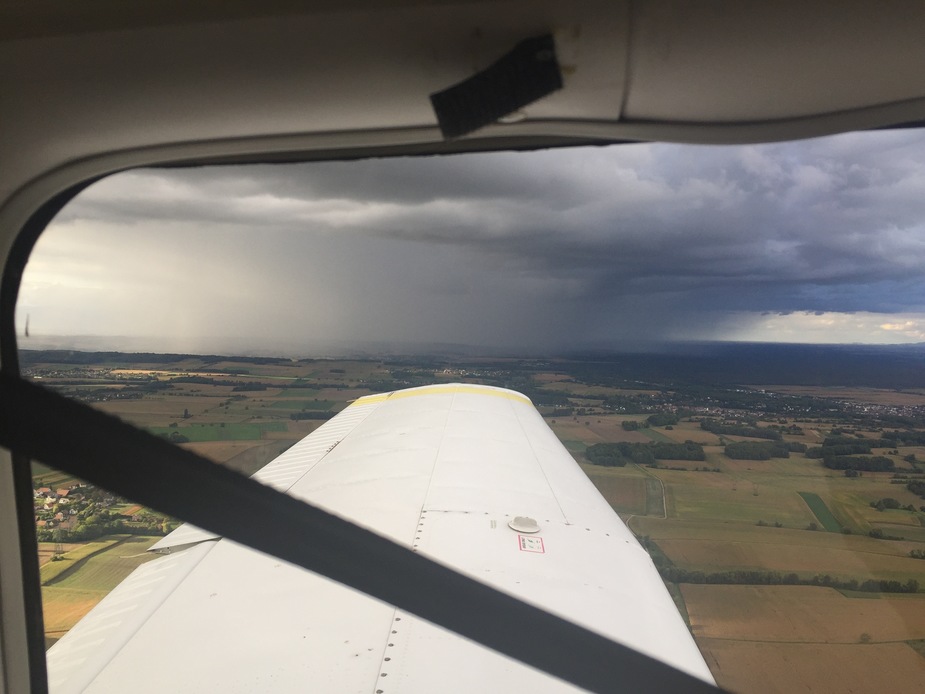on a trip from EGKB to LFSB yesterday, i encountered the trough that peter encountered, which had moved further south-east since then, directly over my destination. with LFSB being my homebase, i decided not to scrap the flight with maybe a little element of “home-itis”. i also had 6 hours endurance for a 2.5 hour flight, giving me plenty escape options.
nevertheless, i don’t like turbulence in IMC. especially not in this rental aircraft with a one-axis Century III autopilot, and an experience where the GNS430-converter (sending AI info to the auto-pilot) failed in flight and gave me 60+ degree bank on an SID departure turn within seconds before i could disconnect it (luckily in VMC). that’s all been fixed since then, but my trust in the (only IFR) aircraft of the club has drastically waned since then… up to the point i prefer hand-flying in IMC. it doesn’t help that there’s only one AI.
about 40 NM @ FL170 from the beginning of the STAR, i identified TCUs (circled red) estimated over the vicinity of LFSB, as well as a potential clearing well before (green):

had this been at the en-route stage, i would have simply circumnavigated or out-climbed (Turbo Arrow IV). but soon the STAR was to begin with mandatory descents and prescribed routings and vectors – right through that stuff. or maybe not, maybe there would be enough clearings to navigate through.
options:
1) descend through the clearing ahead (if it is one), cancel IFR and proceed VFR below.
2) maintain altitude until destination and check whether there’s clearings there, if not divert to the west where SATIR showed clear skies.
3) fly STAR and approach
option 3 was out of the question for all reasons mentioned in this thread. option 2 was safe, but impracticable within the TMA/CTR of an international airport and would also be detrimental to slow engine cooling.
therefore option 1. not that this option is without risk (ceilings? terrain? airspaces?), but the METARs stated ceilings >= 2500ft and i know the area very well VFR. also, there was Nancy airport just below the clearing for a quick diversion should ceilings be too low.
sure enough, the clearing presented itself:


i requested “cancel IFR and visual manoeuvring” at FL170 and ATC immediately granted unrestricted descent and manoeuvring. i dropped the gear and descended on 65% cruise power with 1200fpm keeping the engine warm. autorouter must have thought i crashed:

even under the flat cloud layer (@ FL120, -2°) there were some cumulus:

going under the far end of the clearing:

the descent was very smooth, not a single bump. the ceilings were between 3000 and 4000 feet, not a problem VFR. in spite of a tailwind of 15kts at 3000 ft there was no turbulence. i proceeded direct destination, and sure enough the two red circles were identified.
this one was sitting where the STAR would be:

and this one was sitting directly on the ILS axis around the FAF:

the only bumps felt were on final for RWY 15, probably some outflow air from the TCU in the back. 5 minutes after landing the airport got washed by this one :) quite glad, it removed the last salt traces of my Barra trip. quite glad i experienced it on the ground.
the decision turned out to be the right on for this situation. if the destination were in an unfamiliar area or with no escape options, i would have scrapped the flight. it proved invaluable to have a satphone for metars. that of course only works in an area with enough METAR’d airport density.
Great photos and analyzing. And welcome! Tell more about how Barra went!
boscomantico wrote:
Great photos and analyzing. And welcome! Tell more about how Barra went!
thank you. i have learned so much from this forum. i will write trip reports for my extended scotland trip including Barra.
Solaris – great post.
A big thank you from me as well. Great way to share a lesson learned or simply a story from the trenches with pictures like these.
As you mentioned the STAR… What if the weather would have been IMC all the way? On a device like ADL we can see – albeit with a significant delay – the worst stuff. But this is not good enough to navigate through it only to make a wide turn around it.
I assume ATC in terminal areas do have weather radar and do know that a TCU is sitting on top of the ILS. Airliners certainly don’t want to fly the ILS through a TCU either. So we will end up in a hold to wait it out – right?
What about diverting then? Does that ring a bell?
Sorry, but if…
then you better be prepared to deviate right before starting the flight. Otherwise, there is something bad with the planning. These planes are not all-weather machines.
Stephan_Schwab wrote:
I assume ATC in terminal areas do have weather radar and do know that a TCU is sitting on top of the ILS. Airliners certainly don’t want to fly the ILS through a TCU either. So we will end up in a hold to wait it out – right?
Hi Stephan, there has been an interesting discussion on this topic earlier this year, see: Weather in the terminal area
Stephan_Schwab wrote:
I assume ATC in terminal areas do have weather radar and do know that a TCU is sitting on top of the ILS.
I would not trust on that. Most ATC haven’t got any kind of weather radar. You are the commander of the aircraft and you have to tell them where you can fly and where not. ATC is to avoid collisions, but weather is sole responsibility of the pilot.
And Philipp is right, there is a reason why you put an alternate aerodrome in your flight plan. This is not binding. If you think you can land somewhere safer, you should go there.
It’s not only about if the TS is on the ILS – if you have flown into the rotor of an approaching TS you’ll understand that you better stay well clear of any thunderstorms.
Three years ago I flew in 3000 ft towards my home field that is close to Munich airport (10 miles). I was on a westerly heading. On the ATIS i heard that there was a TS above the airport and I could see it from 30 miles away. It was also clear that the area where my airport is was clear, …no cloud over the airport.
10 miles before my field i flew into such strong turbuence that it scared the shxxt out of me! I diverted to the north and approached the field from the other side, and that was ok.
That was in my Warrior and for a second i thought it would break apart. It was probably far from that – but still, it was no fun.
Stephan_Schwab wrote:
As you mentioned the STAR… What if the weather would have been IMC all the way? On a device like ADL we can see – albeit with a significant delay – the worst stuff. But this is not good enough to navigate through it only to make a wide turn around it.
i scrap every flight where i cannot maintain VMC on top and/or the terminal weather will be full IMC with even a slight chance of convective elements and no VFR alternative. certainly on the analogue platform i’m flying. if i had FIKI and a true radar, maybe i would become more daring. my post above was certainly a case of home-itis combined with good knowledge of the area for VFR operations.
see this illustrative video DA42+radar: